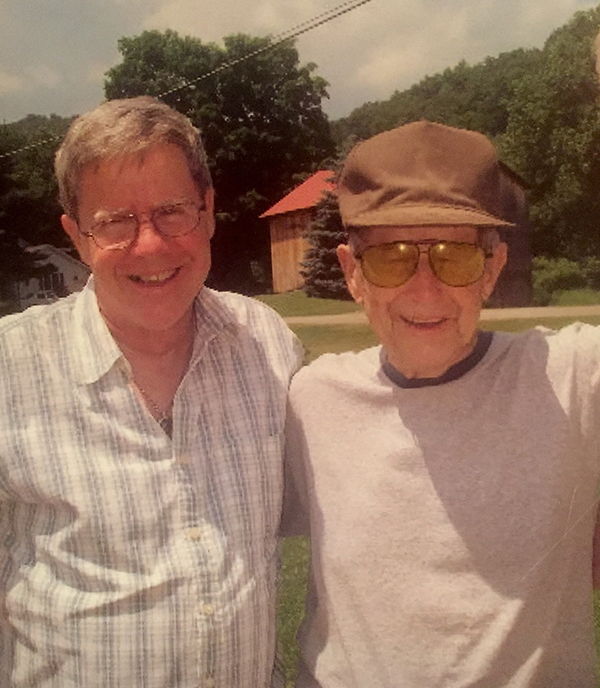Parallel Paths to the Pacific, in War and Peace

Over two generations, my father and I — Dick and Rick Ziegler — followed a similar journey to Hawaii and beyond, to high jungle islands in the far Pacific, for a formative time in both our lives. Fortunately, we went there for different reasons and causes — war and peace, soldiering and teaching.
My father, Dick Ziegler, enlisted in the Army after the Japanese attack on Pearl Harbor, Hawaii on December 7, 1941. Eighty years ago, in August 1942, he found himself on a distant island he had never heard of — Espiritu Santo — in the New Hebrides, now known as Vanuatu. He had been trained as a radar operator, a technology quite new, and assigned to the 674th Signal Aircraft Warning Company, 3rd Fighter Command. Their critical task was watching for Japanese ships and planes coming down the Solomon Islands channel called The Slot, trying to resupply Japanese forces fighting the American Marines on Guadalcanal, the first great pivotal land battle in the Pacific War, after six brutal months, an American victory.
My father’s war was over when he was sent home after contracting malaria and dengue fever, and he suffered aftereffects for several years. He brought back many stories of his experiences there that fascinated me as a boy - boar hunting with the islanders, unloading wounded Marines from Guadalcanal, seeing the first submarine-launched Japanese plane on radar, tales of the battles on unknown islands and seas, and even native headhunters. Another Pennsylvanian assigned there was James Michener, who wrote the award-winning book TALES OF THE SOUTH PACIFIC, based on his experiences, and later made into a play and two movies. His souvenirs also intrigued me — a war club, a boars tusk armband, sea shells and beautiful fishhooks. Those stories and artifacts were to change my life 26 years later.
Little did I know then that I would follow in his footsteps, though thankfully, for different reasons. When I graduated from Allegheny College in 1968, I chose the Peace Corps rather than law school. The uproar in the country was something I wanted to escape from. I could have requested an assignment as a teacher almost anywhere in the world, but I picked a Pacific Island. I didn’t know or care which one. I ended up like him on an island I had never heard of — Ponape, now known as Pohnpei — in the Eastern Caroline Islands. Espiritu Santo was 3500 miles southwest of Hawaii, and Ponape was about 3000 miles west. Both are high islands with heavy jungle and high rainfall, surrounded by a fringing coral reef. My father arrived by ship - the President Coolidge in 1942 — and I came on the James Cook in 1968.

Ponape was part of the Japanese Empire we were trying to conquer - on the path back to Tokyo. The village I was initially assigned to had been a substantial Japanese town with a sugar mill, a railroad line, a sake factory, and extensive fields of sugar cane and sweet potatoes. Ponape was not invaded but was heavily bombed with about 250 raids, reducing this town to piles of rubble. When I arrived in 1968, all that remained were wrecked buildings, concrete foundations, overturned rail cars, and huge bomb craters. The islanders had many stories about the war and the Japanese times. Twenty-three years after the war, the islands of Micronesia, as they are now known, were covered with the wreckage of weapons and war - rows of Japanese tanks, sunken ships, Japanese Zeroes in lagoons, big cannons sticking out of caves. And memorials like that at Suicide Cliff in Saipan, where thousands of Japanese civilians leaped to their deaths rather than surrender. Now, half a century on, the scars of war are buried deep in the jungle and lagoons on dozens of islands. On Pohnpei, there were also the ruins of an earlier age, like the spectacular Nan Madol ruins, the Venice of the Pacific built on the reef over 800 years ago. I explored them in my outrigger canoe — a fortress of a lost age.
Growing up in western Pennsylvania, I thought water was brown and skies were gray. The brilliant greens and blues of the far Pacific Islands dazzled me. There were purple sunsets, white moonlight on the coral and lagoons, and endless waterfalls with 300 inches of rain. But it wasn’t all paradise — 90-degree temperatures and humidity even higher, mud, mosquitoes, torrential downpours, and mangrove swamps galore. No roads meant travel by boat or hiking through ankle-deep mud — plenty of parasites, lots of infections, mold and mildew on everything. Honestly, I do not know how the men of my father’s generation fought in such horrific conditions. It was a “war without mercy,” as one book title described it. Atrocities, torture and unspeakable massacres are sadly well-documented.
The Pacific odysseys of my father and I did not end there. After completing my Peace Corps service in 1970, I moved to Hawaii for graduate school, married a pretty Polynesian lady, and had a 40-year career as a history professor at Honolulu Community College. My father moved there himself in 1985 after my mother passed away, and we lived in the same condo complex on Windward Oahu. He eventually moved back to the Oil City area, and in 2011, I followed him home. I had four years of overlap with him until he passed away in 2015.
My experiences in the Islands and history knowledge gave me the confidence to co-author an alternative history of the Pacific War called RED SUN in 2001. We dedicated the book to our fathers’ generation on both sides. The grandfather of my co-author’s Japanese wife died on Guadalcanal. Now even my Peace Corps time is 54 years in the past. That experience changed the direction of my life, and I owe that largely to my father’s wartime service 80 years ago.
